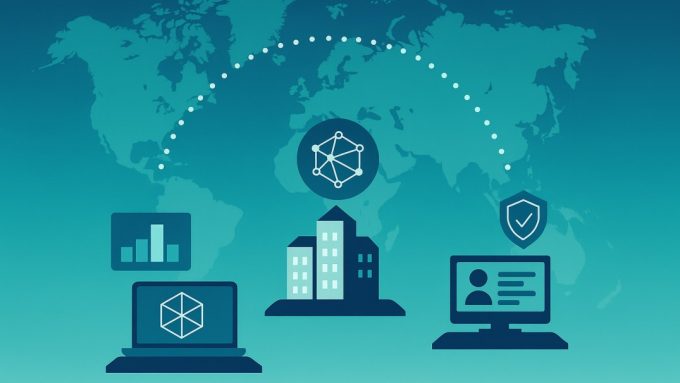
At the recent Digital Twin conference in London on 30 October 2024, the Digital Twin Hub had the privilege of hosting an enlightening panel discussion that showcased how digital twin technology is transforming maritime operations. The session brought together William Barker, Harbour Master at Harwich Haven Authority, and Toby Mills from Entopy, offering a compelling glimpse into the future of port operations through digital innovation.
Scale and complexity: The maritime challenge at Harwich Haven
The panel discussion opened with William Barker, Harbour Master at Harwich Haven Authority, painting a vivid picture of one of the UK’s most historically significant and operationally complex ports. “Harwich has been an important port since Roman times,” William explained, “basically serving as a key hub that used to supply England’s first city, Colchester.” This historical significance has evolved into a modern-day maritime operation of remarkable scale and complexity.
The numbers behind the operation
Today’s Harwich Haven Authority manages an operation that showcases the sheer scale of modern maritime commerce:
- An expansive jurisdiction covering 150 square miles of waterway – an area that requires constant monitoring and management
- A network of 42 miles of deep-water channels, maintained through significant investment including a recent £130 million dredging project
- Coordination of approximately 15,000 commercial vessel movements annually
- Skilled management of 3,500 piloted vessel movements, each requiring precise timing and expert navigation
- Handling of vessels up to 400 metres in length – a scale William illustrated by comparing it to “four football pitches end-to-end”
Navigating complexity
What truly sets Harwich Haven apart is the intricate balance required to manage these massive operations alongside local maritime activities. “My job as Harbour Master, ensuring vessels can safely come in and out and discharge their cargoes, probably hasn’t changed for hundreds and hundreds of years,” William reflected, “but the technology certainly has.”
The complexity becomes evident when considering the diverse range of activities occurring simultaneously within the harbour:
- Super-sized container vessels carrying up to 24,000 containers
- Local fishing vessels maintaining traditional fishing grounds
- Recreational activities including swimming and paddle boarding
- Small pleasure craft and tourist boats
- Environmental considerations and protected areas

As William described, “When you look at that photo, that’s actually Felixstowe from this window, and at the front there, you can see there’s a fishing boat, a beach where we have people swimming, and behind them some of the world’s biggest ships. In fact, the two berths at the back, on the right-hand side, handle about 20% of the country’s containers through there.”
Critical operational considerations
The management of such diverse maritime traffic requires careful attention to several critical factors:
- Underwater clearance: “When you look at these massive ships that might displace up to about 290,000 tons… the amount of water actually underneath them is potentially only about a meter and a half – 4.7 metres, so less than the height of me,” Barker explained, highlighting the precision required in navigation.
- 24/7 operations: The port operates round-the-clock, requiring constant coordination between multiple stakeholders:
- Vessel Traffic Services (VTS) operators
- Pilot teams
- Tug operators
- Terminal operators
- Ship crews
- Local maritime users
Safety and efficiency
Maintaining the delicate balance between commercial efficiency and safety for all harbour users, from the largest container ships to the smallest paddle boarders.
This complex operational landscape sets the stage for why digital twin technology has become increasingly crucial in modern port operations. As William noted, “Our job is to get that right, to bring these world’s biggest ships in, mixed in with paddleboards and canoes, and make sure they can safely navigate our waters 24/7.”
The scale and complexity of operations at Harwich Haven Authority exemplify why innovative solutions are essential for modern port management, creating the perfect context for the digital twin implementation discussion that followed.
Digital innovation meets operational expertise: Transforming port operations through digital twins
When Toby Mills from Entopy took the stage, he unveiled how digital twin technology is transforming port operations at Harwich Haven Authority. As Toby explained, this implementation represents a sophisticated approach to managing the intricate dance of maritime operations, where precision timing and resource coordination are paramount.
Understanding the operational challenge
“The brief in this case was what William just described as an incredibly complicated operation,” Toby began. The complexity stems from coordinating multiple moving parts:
- Enormous vessels requiring precise navigation
- Towing operations managed by separate companies
- Skilled pilots executing complex manoeuvres
- Channel navigation requirements
- Berth availability and labour programmes
- Environmental considerations
Key focus areas of the digital twin solution
- Predictive vessel tracking
The solution begins its work long before vessels reach British waters. “We started by picking vessels up way, way out at sea,” Toby explained. “So I’m talking way off the coast of Africa and understanding when they’re going to arrive.”
This early tracking enables:
- Accurate arrival time predictions
- Early identification of potential delays
- Proactive scheduling adjustments
- Better resource allocation planning
- Reduced fuel consumption through optimised vessel speeds
2. Resource optimisation
The digital twin solution addresses one of the most complex aspects of port operations – coordinating multiple stakeholders and resources. This includes:
Stakeholder coordination:
- Pilot availability and scheduling
- Tug boat operations and positioning
- Berthing team readiness
- Terminal resource allocation
- Labour force management
Resource management:
- Real-time tracking of available resources
- Predictive modelling of resource needs
- Dynamic scheduling adjustments
- Optimisation of resource deployment
- Minimisation of idle time
3. Constraint management
Perhaps the most innovative aspect of the solution is its ability to identify and predict operational constraints before they impact vessel movements. “The absolute objective of this project,” Toby emphasised, “is to basically model all the data parameters, and understand, monitor and predict all of these constraints and help people to mitigate them.”
Key constraints monitored:
- Tidal conditions and water depths
- Weather impacts on operations
- Berth availability and conflicts
- Pilot and tug availability
- Channel traffic and passage timing
- Labour resource availability
Proactive solutions:
- Early identification of potential bottlenecks
- Alternative scenario modelling
- Real-time adjustment recommendations
- Risk mitigation strategies
- Resource reallocation suggestions
Simulation capabilities
A particularly powerful feature of the solution is its ability to simulate operational changes. As Toby described, “Setting aside the basics, this is to be able to essentially simulate what would happen if you were to change certain resources in certain areas.”
This simulation capability enables:
- Testing of different operational scenarios
- Impact assessment of resource changes
- Optimisation of process workflows
- Training and skill development
- Continuous improvement of operations
Early results and impact
Though only three months into the delivery phase, the project is already showing promising results. The system is successfully:
- Tracking vessels from long distances
- Predicting arrival times with increasing accuracy
- Identifying potential constraints before they become problems
- Supporting more efficient resource allocation
- Contributing to reduced vessel waiting times
Environmental impact and future vision
A significant portion of the discussion focused on environmental considerations. William Barker highlighted that some vessels can burn up to 200 tons of fuel per day, emphasising the potential impact of even small efficiency improvements. The panel outlined several key environmental initiatives:
- Transition to alternative fuels like methanol
- Optimisation of vessel arrival times to reduce fuel consumption
- Integration with wider environmental monitoring systems

Looking ahead: The Smart Shipping Accelerator Programme
The discussion concluded with exciting news about the recently awarded Smart Shipping Accelerator Programme. This initiative will:
- Extend the current digital twin implementation to benefit the wider maritime network
- Focus specifically on emissions reduction
- Create stronger connections between ports, shipping lines, and supply chain partners
Key takeaways
- Integration is critical: Success depends on bringing together operational expertise with technological innovation
- Practical implementation: Digital twins must deliver tangible benefits to gain widespread adoption
- Environmental focus: Sustainability is a key driver for digital transformation in maritime operations
- Collaborative approach: The future of maritime operations relies on stronger partnerships between stakeholders
Impact on the wider maritime sector
The panel highlighted how this work could benefit:
- Port operations across the UK and globally
- Supply chain efficiency
- Renewable energy sector
- Infrastructure development
- Future maritime technology adoption
Get involved
Through our Gemini Firebox initiative, we’re creating more opportunities for similar transformative collaborations. If you’re an infrastructure owner or innovator interested in being part of this digital transformation journey, we’d love to hear from you.
Contact us today to explore how you can be part of this exciting initiative:
Register your interest to contribute towards shaping the future of infrastructure through digital innovation. Whether you’re facing operational challenges or have solutions to share, Gemini Firebox provides the structured platform you need to turn digital twin potential into practical reality.


Leave a comment